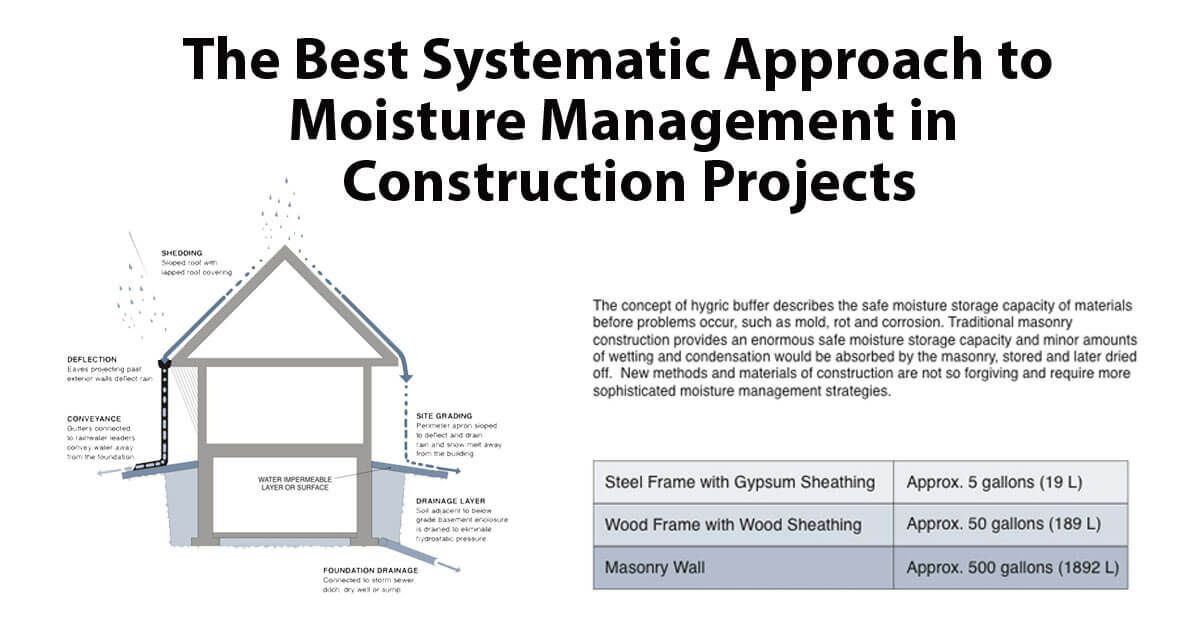The Best Systematic Approach to Moisture Management in Construction Projects
TweetWell-designed buildings have many virtues among them, the ability to serve their intended purposes and to sustain an essential shelter for human activities. Most building durability attributes can be affected by Moisture.
The two most common sources of moisture that impact below grade construction are infiltrating moisture and condensing moisture. The two have different concepts but the factor that joins them is temperature.
Moisture can influence construction in many ways.
- Firstly, moisture can pressurize against the surfaces of below grade construction and force its way through voids in the construction creating leaks.
- Secondly moisture can transmit heat 25 times more efficiently than air to the exterior surface of the below grade construction.
- Thirdly if the soil conditions of the lot are not appropriate for below grade construction and have a low budget it is wise to choose a different foundation.
Impact of Moisture in Buildings
Uncontrolled Moisture may reduce the structural soundness of buildings through dry rot in wood, corrosion in steel, freeze thaw cycles, spalling and efflorescence in masonry among other damage mechanisms.
Moisture can also affect the health of occupants, typically through the potential for breeding harmful organisms. In other words, uncontrolled moisture will adversely affect the most vital attributes of the buildings.
Moisture management, like all environmental control, is achieved through the selection and arrangement of the materials comprising building enclosures. The selection of suitable materials responds to the imposed environmental conditions in terms of heat, air, moisture, and solar energy flows.
The Building components must be able to manage these phenomena implying sufficient resistance and adequate service life. It is also critical to arrange these materials properly in order to safely manage the moisture loads. A material that is ideally suited to one control function may be entirely unsuitable for another. Placing a material in the wrong location can also have serious performance implications.
How to Control Bulk Water?
The control of bulk water in building enclosures predominantly involves rain control theory, although in some cold regions, snow accumulations and wind-driven snow present special challenges. Below grade building components must manage precipitation that percolates through soil as well as fluctuations in the local water table.
Selection of suitable wall type in accordance to precipitation exposure is a must, but insufficient condition for adequate moisture management.
Over the past several decades a great deal of research and development has gone into materials comprising the drainage plane. These water-repelling materials (sheathing paper, house wrap, sheet/roll membrane, trowel-applied mastic coating, foam insulation, coated structural sheathing, etc.) are located on the backside of the drainage space behind the cladding, to form a drainage plane.
They are interfaced and/or interconnected with flashings, window/door openings, penetrations, and transitions across the building enclosure to effectively drain away to the exterior any water that penetrates the cladding.
Conclusion
Construction specifications should clearly state excavation dimensions required to safely and efficiently construct the below-grade structure and minimize the size of open excavation, therefore, minimizing the amount of water entering the excavation.
One should also note a number of Moisture Management Concerns that must be addressed at the intersection of the basement wall, basement floor, structural footing and water infiltration, and soil gas/contaminated air infiltration.
If the drainage system is at the right design, the drainage venting and temperature can be addressed within one system and thus the building will require little or no maintenance at all.

